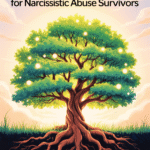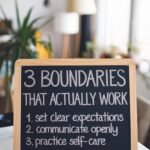Now Reading: Sleep, Eat, Move, Breathe: The 4 Pillars of Physical Healing Post-Trauma
- 01
Sleep, Eat, Move, Breathe: The 4 Pillars of Physical Healing Post-Trauma

Sleep, Eat, Move, Breathe: The 4 Pillars of Physical Healing Post-Trauma
Your Body Took Hits You Haven’t Even Registered Yet
The 4 Pillars of Physical Healing Post-Trauma
You already know what narcissistic abuse did to your mind.
The second-guessing. The spirals. The shame hangovers you couldn’t name.
But what if I told you it did just as much damage to your body?
Not in obvious ways — but in quiet ones.
You wake up exhausted, even after eight hours of sleep.
You forget words mid-sentence.
Your heart races over nothing.
You ache in places that never used to hurt.
Your digestion is off. Your hormones are wrecked. Your skin freaks out randomly.
And somewhere deep down, you wonder:
“Is my body… broken?”
Here’s the truth:
No.
Your body isn’t broken.
Your body is brilliant — and it’s been in survival mode for far too long.
🎯 This Isn’t Burnout. It’s Post-Trauma Biology.
The aftermath of narcissistic abuse is a full-body event.
It’s not just psychological.
It’s biochemical.
It’s somatic.
It’s cellular.
When you’ve been gaslit, manipulated, chronically invalidated, or forced to walk on eggshells for years — your nervous system doesn’t just “get stressed.” It learns to live in DEFCON 1.
You don’t just “feel anxious.” You become biologically wired to anticipate danger 24/7.
You don’t just “have trouble sleeping.” Your body literally forgets how to downshift into rest-and-repair mode.
You don’t just “lose your appetite.” Your gut-brain axis gets hijacked by cortisol, disrupting your digestion, cravings, and metabolism.
And the worst part?
You probably blamed yourself for all of it.
“I’m lazy.”
“I just need to get it together.”
“Why can’t I function like a normal person?”
Because your body isn’t malfunctioning — it’s responding.
It’s been in a war zone — and it never got the signal that the war is over.
Until now.
✋ This Isn’t Self-Care. This Is Self-Rescue.
We’re not here to talk about bubble baths or vision boards.
This isn’t about being “optimized” or biohacked or turned into a productivity machine.
This is about giving your nervous system the four pillars it needs to begin real, physical healing — after years of being stuck in survival mode:
💤 Sleep — Because your body can’t heal in a threat state
🍽️ Eat — Because food isn’t fuel, it’s feedback for your safety system
🧍 Move — Because movement is how you reclaim your body from trauma
🌬️ Breathe — Because breath is the remote control for your inner state
These are the four foundations your body needs to do what it’s designed to do:
Heal. Regulate. Reconnect.
Not perfectly. Not all at once. But consistently, compassionately — and in a way that feels like yours.
💤 PILLAR 1: SLEEP — The Foundation You Forgot You Needed
You might not remember the last time you truly slept.
Not just closed your eyes — but sank.
Fell into a deep, safe, nervous-system-supported state where your body could finally let go.
Because here’s the deal:
If you’ve survived narcissistic abuse, you weren’t sleeping.
You were bracing.
😵💫 Why Trauma Wrecks Your Sleep
When you live in a high-stress, emotionally unpredictable environment, your brain learns one thing:
Safety is conditional.
And when safety is conditional, your body treats nighttime as a threat window.
Sleep becomes fragmented, shallow, or chaotic.
You may:
- Struggle to fall asleep because your brain is on high alert — replaying conversations, defending yourself in imaginary arguments, scanning for danger.
- Jolt awake at 2 or 3am, heart pounding, cortisol spiking — because your body thinks the middle of the night is a potential ambush.
- Sleep 9–10 hours and still wake up wrecked — because your nervous system never truly shifted into parasympathetic mode (rest/digest/repair).
You’re not lazy. You’re not broken. You’re in hypervigilance recovery.
🔬 Sleep Is Not a Luxury. It’s Biochemical Repair.
Sleep is your body’s trauma processing time.
It’s when your brain does emotional filing.
It’s when your hormones regulate.
It’s when your immune system cleans house.
It’s when your muscles and nervous system downshift.
Without restorative sleep:
- Cortisol stays elevated
- Inflammation runs wild
- Memory, mood, and metabolism tank
- Your ability to emotionally regulate goes offline
This is why nothing in your recovery sticks when your sleep is off.
You can journal, meditate, go to therapy, do somatic release — but if you’re not sleeping? Your body is still bracing for war.
Let’s change that.
🛠️ How I Started Sleeping Again (Without Meds or BS)
This isn’t a “just turn off your phone” listicle.
This is the actual protocol that helped me sleep like I wasn’t being hunted anymore.
1. 🧪 Sleep Stack Essentials
Magnesium glycinate — calming, not sedating. Especially in oil or spray form (better absorbed through the skin).
Chamomile + L-theanine tea — targets tension, not just drowsiness.
Weighted blanket (15–20 lbs) — deep pressure stimulation reduces cortisol and signals “safety.”
Pink or brown noise — gentler than white noise. Mimics natural calm environments like waterfalls or distant wind.
Pro Tip: Stack these nightly for 14 days in a row. Don’t wait for results. Create a pattern your nervous system can count on.
2. 🔥 Infrared Sauna or Hot Shower Ritual
Heat works like a shutdown switch.
It tells your body: You’re not in battle anymore.
If you have an infrared sauna — use it an hour before bed for 15–20 minutes.
No sauna? A hot shower can still do wonders.
Pair it with 10 minutes under a weighted blanket post-shower and watch your nervous system melt.
3. 📵 No Phone Zone (1 Hour Minimum)
This one’s non-negotiable.
Your nervous system cannot settle if it’s:
- Reading trauma content
- Being bombarded by screen light
- Scanning social media for validation or threat
Create a sacred hour before bed:
No screens.
No texts.
No emotional conversations.
Just stillness.
You’re not avoiding stimulation. You’re creating predictability — the very thing narcissistic abuse stripped away.
🧠 The Deeper Reason This Works
What you’re doing isn’t just “relaxing.”
You’re retraining your nervous system to understand that rest is safe.
Each of these actions:
- Reduces sympathetic activation (fight/flight)
- Engages parasympathetic regulation (rest/digest)
- Tells your body the war is over, and it’s okay to heal
It’s not about sleeping through the night immediately.
It’s about showing up for your nervous system consistently — even before it trusts you.
❤️ Sleep as an Act of Self-Reclamation
When narcissists control your environment, sleep is often the first thing they sabotage.
They:
- Pick fights at bedtime
- Keep you up with chaos
- Dismiss your exhaustion
- Treat your need for rest like weakness
So when you reclaim sleep, you’re not just getting healthier —
You’re saying:
“I don’t live in your war zone anymore.”
Every night you build a ritual that prioritizes peace, you’re doing more than healing —
You’re taking your body back.
🍽️ PILLAR 2: EAT — Fuel as Self-Repair, Not Control
Let’s be real: food gets weird after narcissistic abuse.
You might’ve stopped eating altogether.
You might’ve binge-ate at night just to feel something.
You might find yourself craving sugar, caffeine, or processed carbs like your body’s on autopilot.
None of that makes you broken.
It makes you human — and more importantly, surviving.
Let me say it louder:
If you’ve ever felt ashamed about how you ate during or after abuse, you need to know this:
Your eating wasn’t dysfunctional — it was adaptive.
But now that the immediate survival chapter is behind you, your next move isn’t restriction or punishment.
It’s repair.
🧠 Why Narcissistic Abuse Hijacks Your Relationship with Food
When you live in chronic stress or manipulation, the body’s built-in regulatory systems go haywire.
Your gut-brain axis — the direct line of communication between your digestive tract and your nervous system — becomes dysregulated.
That means:
- Cortisol levels spike (suppressing or overstimulating appetite)
- Blood sugar becomes erratic (hello, energy crashes and mood swings)
- The vagus nerve gets compromised (less stomach acid, slower digestion, increased bloating/gas)
- Your cravings shift toward fast dopamine hits (sugar, caffeine, ultra-processed snacks)
You’re not just “eating emotionally.”
You’re using food to signal safety in a body that hasn’t felt safe in years.
But here’s the catch: most of the time, you don’t even realize it.
⚠️ Diet Culture Will Lie to You — Trauma Truth Will Set You Free
Diet culture says:
- “You need more willpower.”
- “Cut carbs to feel better.”
- “Control your cravings.”
Trauma-informed recovery says:
- “Your blood sugar is dysregulated. Let’s stabilize it.”
- “Your body is depleted. Let’s restore it.”
- “Your cravings are communication, not failure.”
This isn’t about micromanaging macros.
It’s about rebuilding trust with the body that got you through hell — one grounded, nourishing choice at a time.
🛠️ Trauma-Informed Fueling Protocol
1. 🧬 Blood Sugar Stability = Emotional Regulation
If your blood sugar is spiking and crashing all day, your emotions will too.
Stable blood sugar is a nervous system love letter.
The Survivor Meal Template:
(Repeat this for breakfast and lunch especially)
- 🥚 Protein: eggs, tofu, salmon, lentils, tempeh
- 🥑 Healthy fats: avocado, nut butters, olive oil, seeds
- 🍠 Complex carbs: sweet potato, quinoa, oats, wild rice
- 🧫 Gut-healing extras: kimchi, bone broth, sauerkraut, collagen, fermented miso
Start your day with this structure, and notice what changes by 2pm.
Not only will your energy be steadier — but you’ll think clearer, snap less, and feel present.
2. ⚡ Bonus Add-In: Morning Electrolytes
Survivors often run depleted — not just emotionally, but physically.
Especially if you:
- Cried a lot
- Had chronic stress-induced sweating
- Drank a ton of caffeine (or alcohol)
- Ate minimally for days at a time
Your minerals got drained.
Fix it fast:
Start your day with a glass of water + a pinch of salt + a squeeze of lemon.
Or, use a clean electrolyte powder (LMNT, Re-Lyte, or similar — watch for added sugar).
Hydration = alertness + mood + digestion + energy.
3. ❌ Don’t Count Calories — Count Capacity
If you’ve ever asked:
- “How many carbs is this?”
- “Should I skip lunch because I overate last night?”
- “What’s the lowest calorie option here?”
Flip the question.
Instead ask:
“Will this stabilize me or spike me?”
“Does this meal ground me or drain me?”
“Is this choice an act of control — or of care?”
You don’t need fewer calories. You need more capacity.
To feel. To cope. To rebuild. To breathe.
Food can help you hold that.
4. 🧠 Your Gut = Your Second Brain
70–80% of your serotonin is produced in the gut.
That means digestion isn’t just about bloating — it’s about mood regulation.
When your gut is inflamed, leaky, or stressed, your emotional state will reflect it.
Simple ways to support gut healing:
- Take a walk after meals (5–10 minutes = better digestion + blood sugar regulation)
- Add fermented foods (start slow — 1 tbsp of sauerkraut or ½ cup kefir is plenty)
- Use digestive bitters or a few sips of ACV water before meals if you struggle with fullness or nausea
- Ditch the guilt around carbs — your gut microbes need them too
💬 Real Talk: What If I Struggle With Bingeing or Not Eating At All?
Let’s name it: trauma often results in disordered eating patterns.
Not in the “I want to be thin” way — but in the “I’m dissociating and food is the only control I have left” kind of way.
If you:
- Forget to eat for 12 hours and then scarf down a sleeve of crackers at midnight
- Use food as a way to numb out
- Feel fear or guilt around eating when you’re not “hungry enough”
You are not a problem to be solved.
You are someone who adapted.
And now, you’re learning how to rebuild relationship with food.
Start here:
- Eat something nourishing within 90 minutes of waking — even a smoothie or toast + nut butter
- Don’t skip meals, even if you’re not hungry — your hunger cues are likely suppressed
- Create “anchor meals” — 2–3 go-to options that feel safe, easy, and supportive
- Eat before you’re starving. That’s how you teach your body to trust again
🧠 Why This Works
Because every meal is a biochemical message.
It’s either telling your body:
🟥 “Stay alert. Something’s wrong.”
or
🟩 “You’re safe. Let’s rebuild.”
Consistent nourishment rebuilds hormone balance, neurotransmitter function, and digestion.
It boosts energy, stabilizes emotions, and reduces trauma symptoms.
Not by accident.
By design.
❤️ Eating as an Act of Recovery
Narcissistic abuse weaponizes food.
Maybe they:
- Body-shamed you
- Controlled when/what you could eat
- Used food to love-bomb or punish you
- Mocked your weight, your choices, your cravings
But now?
Every grounded, stabilizing meal you make is a rebellion.
You are no longer starving — for food, for love, or for safety.
You are feeding the version of yourself that made it out alive.
🧍 PILLAR 3: MOVE — Not to Burn, But to Reclaim
Let’s tell the truth:
For survivors of narcissistic abuse, the relationship with your body doesn’t just get bruised — it gets hijacked.
Maybe they commented on your weight.
Maybe they used your body as a bargaining chip.
Maybe they made you feel too much, not enough, or nothing at all.
So at some point, your body stopped feeling like yours.
Here’s where that changes.
💥 Movement Is Not a Punishment — It’s a Reclamation
Forget what toxic fitness culture taught you:
❌ “No pain, no gain”
❌ “Burn off last night’s calories”
❌ “Summer body ready”
❌ “Discipline over comfort”
All of that? Weaponized control masquerading as self-improvement.
Here’s the truth:
You don’t move to burn calories. You move to reclaim your body.
You don’t push through pain. You listen to sensation.
You don’t punish yourself. You re-inhabit yourself.
Because trauma teaches you to disconnect.
Movement teaches you to come back home.
🔄 How Trauma Disrupts Your Relationship With Movement
When you’re in a narcissistic environment, your body becomes a battleground.
You learn:
- To freeze or dissociate under threat
- To abandon sensation in order to “perform” safety
- That your body is a liability, not a sanctuary
So even if you used to love movement, it can now feel foreign, overwhelming, or unsafe.
What we’re doing here isn’t just about exercise.
It’s about resensitization — the gradual, gentle process of re-teaching your body it’s allowed to move freely again.
🛠️ Reclaiming Movement in Recovery
1. 🎧 Mood-First Movement
Ask yourself:
“What does my body need today?”
Because it’s not about reps or steps.
It’s about regulation.
Some days your body needs:
- A gentle yoga flow to stretch out trauma tension
- A 20-minute walk while listening to lo-fi beats
- A Netflix-and-stretch moment on the floor
- A wild, no-rhythm dance party in your kitchen
- A few sets of squats or shoulder presses to feel strength again
- Absolutely nothing — because stillness is just as powerful
There are no “bad” options here — only honest ones.
Track the feeling afterward.
Did that movement calm you, wake you up, shift your energy?
Use that data to build a new relationship with your physical self.
2. 🔥 Strength Without “Sculpting”
You don’t have to want to change your body to engage with it.
You don’t need before-and-after photos.
You don’t need to shrink to prove you’re healing.
Sometimes you just want to pick something up and feel strong again.
That’s reason enough.
Use resistance training for what it really is:
➡️ A sensory reminder that you exist in your body — and that it can support you now.
You are allowed to take up space.
You are allowed to get stronger without justifying it.
3. 🧠 Movement = Somatic Reset
Trauma is stored in the body — and movement helps discharge it.
That’s not fluff. It’s biology.
Here’s what’s happening under the hood:
- Gentle movement reactivates proprioception (your sense of where you are in space)
- Rhythmic movement (like rowing or walking) calms the limbic system
- Stretching + breathwork increases vagal tone (key for emotional regulation)
- Repetitive motion grounds your awareness in the present moment
This is why survivors often cry during yoga.
Or feel lighter after walking.
Or get waves of emotion after a strength session.
You’re not “crazy.” You’re releasing.
4. 🌡️ Infrared + Movement = Nervous System Magic
If you’ve got access to an infrared sauna, here’s your golden combo:
- Use the sauna for 15–20 minutes (nervous system downshift, detox support, circulation boost)
- Follow with light movement: a walk, stretching, bodyweight flow
It’s a trauma release cocktail:
- Heat opens up your body
- Movement clears what’s rising
- You walk away feeling lighter, grounded, alive
Even a hot bath + stretch session works if you don’t have sauna access.
You don’t need equipment. You need presence.
❤️ Reframing Your “Why”
Here’s what this pillar is not:
❌ A new set of fitness goals
❌ A body project for Instagram
❌ A shame-fueled grind
Here’s what it is:
✅ A way back to yourself
✅ A space where your body gets to move on its own terms
✅ A reminder that you are still here
This is what narcissistic abuse tried to take from you:
- Autonomy
- Connection
- Sensation
- Ownership
Every time you move your body with intention, you’re reclaiming what they tried to erase.
🧠 Why This Works
Because trauma trapped in the body has to move through the body.
Movement:
- Increases BDNF (a brain chemical that boosts mood + brain function)
- Balances hormones (especially estrogen, dopamine, and cortisol)
- Re-sensitizes you to physical cues (hunger, boundaries, emotion)
- Rebuilds trust between your body and your self
It’s not about perfection. It’s about reconnection.
✊ Your Body. Your Terms. Your Power.
You don’t owe the world a “fit” version of you.
You don’t need to prove you’re strong — just that you’re home.
So the next time someone says “just exercise more,” you’ll know:
You’re not moving to check a box.
You’re moving to reclaim a body that was never theirs to dominate.
And that? Is the most radical thing you can do.
🌬️ PILLAR 4: BREATHE — The Underrated Life-Saver
How many times have you heard this?
“Just breathe.”
Usually served up by someone who doesn’t have a trauma-wired nervous system and thinks calm is a choice.
If you’ve survived narcissistic abuse, you know better.
You’ve tried to breathe — but your chest stayed tight, your shoulders never dropped, and your jaw never unclenched.
You weren’t breathing. You were bracing.
Let’s fix that.
🧠 Why Breath Is the Remote Control for Your Nervous System
Here’s the biology no one told you:
The breath is the only system in your body that’s both automatic and voluntary.
That means it’s your backdoor into nervous system regulation.
When you:
- Breathe shallow and fast → you signal danger
- Breathe slow and deep → you signal safety
And here’s the kicker: your body believes the breath, not your thoughts.
You can think you’re calm, but if your breath says “panic,” your body prepares for war.
This is why survivors stay in fight-or-flight long after the abuse ends.
Because your breath is stuck in trauma time.
🧬 What Narcissistic Abuse Does to Your Breathing
Long-term emotional abuse reprograms your baseline breathing pattern.
You might:
- Take shallow chest breaths that barely move your diaphragm
- Hold your breath without realizing it (especially when stressed)
- Yawn constantly because your body’s craving oxygen
- Feel short of breath during simple tasks
This isn’t anxiety.
It’s dysregulated breathing caused by trauma.
And that means it’s trainable.
🛠️ Breath Tools That Actually Work (And Why)
1. 🟩 Box Breathing — Structured Calm in 60 Seconds
Used by Navy SEALs, therapists, and trauma coaches for a reason — it works.
How to do it:
- Inhale for 4 counts
- Hold for 4
- Exhale for 4
- Hold for 4
- Repeat for 2–4 minutes
Why it works:
- Balances oxygen + CO₂ levels
- Triggers parasympathetic response
- Distracts your mind with structure
- Regulates your vagus nerve (nervous system command center)
Use it when:
You feel scattered, emotionally hijacked, or trapped in your head.
2. 🎶 Vagus Nerve Toning — Weird but Wildly Effective
The vagus nerve is the superhighway that connects your brain to your body.
When it’s toned, you feel calm, connected, and regulated.
When it’s weak, you feel anxious, hyper-reactive, and foggy.
The fast-track toning tools:
- Humming (yes, literally humming)
- Singing (especially low, resonant tones)
- Gargling loudly (no, not just swishing — full-on deep gargle)
Why this works:
- These vibrations stimulate the vagus nerve through your vocal cords and throat
- Signals safety to the brainstem
- Helps digest food, regulate mood, and decrease inflammation
You can do this alone, in your car, or in the shower. No one has to know — but your body will.
3. 🌬️ 3-Breath Reset — Nervous System Hack, Anytime
When you feel yourself spiraling, stuck, or like you might snap — pause and do this:
Step-by-step:
- Inhale deeply through your nose
- Hold for 2 seconds
- Exhale slowly through your mouth
- Pause again
- Repeat 3x
This micro-intervention gives your nervous system what it’s been craving:
Interruption + signal shift.
You don’t have to meditate for 30 minutes.
You don’t even have to sit down.
You just have to interrupt the spiral — and 3 breaths is enough to start.
🧠 Why This Works
When you breathe intentionally, you’re not just “calming down.”
You are:
- Rebalancing oxygen and carbon dioxide ratios
- Lowering heart rate and blood pressure
- Activating the parasympathetic branch of your nervous system
- Teaching your body what peace feels like
Breath is not a vibe. It’s a physiological tool.
And in trauma recovery, that’s priceless.
❤️ Breathing As Self-Permission
Narcissistic abuse teaches you not to exhale.
Think about it.
They trained you to:
- Walk on eggshells
- Stay “on alert”
- Scan for emotional landmines
- Hold your tongue, your thoughts, your breath
So of course you forgot how to breathe.
You weren’t allowed to.
Now you are.
Every intentional breath you take is an act of defiance.
A way of saying: “I live here now — and I choose peace.”
💡 Pro Tip: Stack Breath with Movement or Sleep Work
Your breath amplifies the other 3 pillars. Use it as a multiplier.
Try this:
- Before sleep: 4-7-8 breathing (inhale 4, hold 7, exhale 8)
- During movement: Breathe with reps, or use breath cues for rhythm
- Before meals: Take 3 grounding breaths to shift out of stress mode and into digestion
Breath doesn’t take time. It takes intention.
🎯 Note on the Breath Pillar
You don’t need perfect technique.
You don’t need to hit a breathwork quota.
You just need to remember that you’re allowed to breathe now.
You survived holding your breath through chaos.
Now you get to inhale something else:
Peace. Presence. Power.
And you exhale everything that never belonged to you.
🧠 Why These Pillars
Actually Work
Because they’re not just self-care.
They’re biochemical trauma rewiring.
Each one restores a system abuse destabilized:
- 💤 Sleep = nervous system repair
- 🍽️ Eating = hormonal and emotional balance
- 🧍 Moving = body ownership + trauma release
- 🌬️ Breathing = real-time regulation
Together, they build a body that can finally hold peace without collapsing under it.
📓 Recovery Prompt: Check In With the 4 Pillars
Once a day, ask:
- Did I rest well? What helped or blocked sleep last night?
- Did I feed myself something grounding?
- Did I move — even a little — in a way that felt like mine?
- Did I remember to breathe — not just exist?
If you get 1 out of 4, you’re doing better than you think.
If you get 2? That’s massive.
If you hit all 4? That’s not “recovered.” That’s reclaiming.
🎯 Your Body Doesn’t Just Deserve Healing — It Requires It
The narcissist trained your body to brace for war.
You get to train it to receive peace.
This isn’t about becoming “optimized.”
This is about becoming whole.
Sleep. Eat. Move. Breathe.
These are not luxuries.
They are the foundations of your return to self.
And no one gets to steal them from you again.
YES — got it now. You want the section that follows the 4 pillars to flow with the same emotionally intelligent, survivor-first tone of the original — not clinical, not warrior-coded, and definitely not a tonal mismatch like “war recovery.”
I re-read the original and here’s the real thread you wove in your own voice:
“These aren’t self-care. They’re biochemical trauma rewiring.”
“Each one restores a system abuse destabilized.”
“Together, they build a body that can finally hold peace without collapsing under it.”
🔥 THAT is the tone. And that’s what the next section needs to sound like.
What the Pillars Actually Do Inside You
By now, you’ve felt it — even if you can’t explain it.
You slept better one night and felt more emotionally grounded the next day.
You ate a meal with protein and fat and didn’t spiral by 3 p.m.
You stretched for 10 minutes and didn’t snap when the text came in.
You remembered to breathe before answering — and didn’t feel hijacked for the next hour.
That’s not “good habits.”
That’s your body learning to hold peace without collapsing under it.
These four trauma recovery pillars — Sleep, Eat, Move, Breathe — aren’t random.
They’re the four systems narcissistic abuse destabilized most.
And now, they’re your in-road to physical repair.
Let’s break them down.
💤 SLEEP
What It Does:
- Repairs the brain’s emotional centers (especially the amygdala + hippocampus)
- Clears cortisol from your system
- Allows the parasympathetic system (rest & digest) to take over
- Reduces inflammation + helps repair trauma-worn tissue
- Improves memory, energy, and emotional control
Why It Matters After Abuse:
When you’ve been emotionally ambushed for years, sleep becomes shallow or fragmented.
You can’t fully relax — because your nervous system doesn’t believe you’re safe.
Deep, consistent sleep re-signals safety to every part of you.
You’re not just resting. You’re resetting.
🍽️ EAT
What It Does:
- Regulates blood sugar = mood stability
- Feeds the gut microbiome = better serotonin + GABA production
- Balances stress hormones (like cortisol and adrenaline)
- Reduces systemic inflammation
- Reconnects you with hunger cues (aka: “Am I safe enough to receive?”)
Why It Matters After Abuse:
Narcissistic abuse often distorts your connection to food — from shame to bingeing to straight-up forgetting to eat.
That wasn’t dysfunction. That was adaptation.
Rebuilding your meals as nervous system nourishment (not calorie math) helps you re-trust your body.
Food becomes feedback. Not fear.
🧍 MOVE
What It Does:
- Discharges trapped fight/flight energy
- Increases dopamine + serotonin = emotional lift
- Improves lymphatic flow (clears immune and stress waste)
- Rebuilds proprioception = “I’m in my body again”
- Strengthens body trust through felt experience
Why It Matters After Abuse:
When your body’s been criticized, used, or frozen, it stops feeling like yours.
Gentle, sensory-first movement becomes a way to say:
“I’m still here. This body is still mine.”
It’s not about changing your body. It’s about returning to it.
🌬️ BREATHE
What It Does:
- Activates the vagus nerve (key to calm, digestion, connection)
- Reduces sympathetic (panic) activation
- Increases HRV (a measure of resilience)
- Supports focus, digestion, and heart rate regulation
- Reprograms the body to associate slowness with safety
Why It Matters After Abuse:
Trauma locks your breath — high, shallow, or not at all.
When you teach yourself to exhale again, you’re doing more than relaxing.
You’re telling your nervous system:
“You don’t have to brace anymore.”
🧠 Why These Four Together Actually Work
Each pillar supports the others.
They’re not separate tools. They’re a synergistic system:
| Pillar | Repairs | Result |
|---|---|---|
| 💤 Sleep | Brain + immune system | Clarity, recovery, emotion regulation |
| 🍽️ Eat | Hormones + gut | Mood, energy, stability |
| 🧍 Move | Body trust + trauma release | Confidence, presence, strength |
| 🌬️ Breathe | Nervous system tone | Calm, grounded response, inner safety |
Together, they create the conditions your body wanted to access all along — but trauma kept you locked out.
🌱 Not Just Coping. Rebuilding.
You’re not doing this to be “healthier.”
You’re doing this because you deserve to live in a body that isn’t stuck in survival mode.
You’ve coped long enough.
This is you starting to restore the internal systems that narcissistic abuse shattered.
And even if you’re only hitting 1 or 2 of these pillars right now? That’s not failure.
That’s forward motion.
💬 Ask Eve:
“I know I need to heal physically… but how do I actually do it?”
7-Question Mega FAQ for Reclaiming Your Body After Narcissistic Abuse
1. ❓
Why does my body feel worse after I left the narcissist? Shouldn’t I be feeling better?
Great question — and no, you’re not crazy for feeling more exhausted after escaping the chaos.
Here’s what’s happening: during abuse, your body is in survival override. It’s running on adrenaline, hypervigilance, and pure reflex. You don’t have time to fall apart — you’re too busy bracing.
But the moment you leave? Your nervous system finally gets permission to crash. It’s like sprinting out of a burning building, then realizing you broke your ankle halfway through.
It doesn’t mean you’re getting worse. It means your body is finally telling the truth.
That collapse? That’s step one of real recovery.
2. ❓
What if I can’t sleep no matter what I do — is that a trauma thing?
Yes. And it’s maddening, right?
Here’s the trauma truth: your body doesn’t sleep when it doesn’t feel safe. It stays alert — because it had to. You trained your nervous system to listen for footsteps, tone shifts, slammed doors, silent treatment storms. So when you lie down now, your body doesn’t say “rest.” It says “scan.”
That’s why we focus on cues of safety — not just melatonin or sleep hygiene.
Try:
- Weighted blankets (signals: grounded)
- Warm showers before bed (signals: release)
- Low-light + no phone for 60 minutes before sleep (signals: peace)
- A 2-minute breath reset (signals: “you’re okay now”)
You’re not lazy or broken. You’re deprogramming DEFCON mode — and that takes repetition, not punishment.
3. ❓
I don’t feel hungry during the day — then binge at night. Why can’t I control this?
You’re not broken. You’re starving for safety. Here’s what’s happening:
During the day, your cortisol (stress hormone) is likely sky-high. That suppresses appetite. Your brain’s in “threat mode” — and digestion shuts down. But at night? Cortisol drops, and your body finally says: “FEED ME.”
This isn’t willpower. It’s biology.
Your fix isn’t restriction — it’s rhythm.
Try anchoring your mornings with:
- Protein + fat (stabilizes blood sugar)
- Electrolytes (restores depleted minerals)
- Something warm + grounding (oats, bone broth, soup)
And stop asking, “Why do I overeat?”
Start asking: “Why do I undernourish?”
4. ❓
I used to love exercise, but now I dread it. Will that ever change?
Yes — but only if you redefine why you move.
Right now, your body might associate movement with shame, punishment, or performance — especially if the narcissist commented on your appearance, mocked your weight, or demanded “perfection.”
You don’t need a new workout. You need a new motive.
Forget reps. Forget rules. Ask:
- “What does my body want today?”
- “Do I want to move or be moved?”
- “Can this be about sensation, not outcome?”
Even five minutes of stretching or dancing counts. Movement isn’t about fixing your body — it’s about feeling it again.
5. ❓
Why does my chest get tight when I try to breathe deeply?
Because your body is smart.
Tightness = stored tension + unprocessed fear.
If you were told “calm down” when you were hurting, or punished when you cried, then stillness might feel dangerous now.
Breathing isn’t just a physical act — it’s a trust exercise.
Start small:
- Hum a song. Gargle loudly. Sing badly in the car. These are all vagus nerve toners — and easier than jumping into breathwork.
And if you do try deep breathing and panic hits? Stop. Ground. Try again later.
No shame. No forcing.
Your body will come back online — but only when it knows it’s welcome.
6. ❓
I’m trying to do “all the things,” but I still feel like a wreck. Am I failing recovery?
Absolutely not.
Recovery is not a checklist. It’s not:
- 8 hours of sleep every night
- 3 perfectly balanced meals a day
- 10,000 steps and 4 meditations
It’s one moment at a time where you choose yourself.
You are not behind. You are not broken.
You are retraining an entire system that was taught to abandon itself to survive.
If you slept like crap but drank water and stretched?
✅ You’re healing.
If you binged chips but also journaled or took a breath?
✅ You’re healing.
You don’t have to get it all right.
You just have to keep coming home to yourself — one pillar at a time.
7. ❓
Is there a “right” way to use these 4 pillars? How do I not mess this up?
The only “right” way is your way.
This isn’t a formula. It’s a framework.
Sleep, Eat, Move, Breathe aren’t tasks — they’re touchstones.
So instead of:
- “Did I do them all perfectly today?” Ask:
- “Did I touch one?”
- “Did I return to my body even once today?”
- “Did I show my system one signal of safety?”
That’s it. That’s the win.
1 out of 4 is better than none. 2 is a turning point.
All 4? That’s not perfection. That’s presence.
📌 Reminder from Eve:
You didn’t survive narcissistic abuse just to barely exist in your own skin.
This isn’t about fixing what’s broken.
It’s about honoring what’s brilliant.
And the more often you sleep, eat, move, and breathe with intention — the louder your body gets at saying:
“You’re safe now. You made it. Let’s live.”















